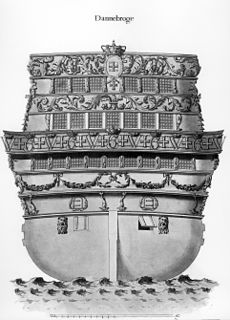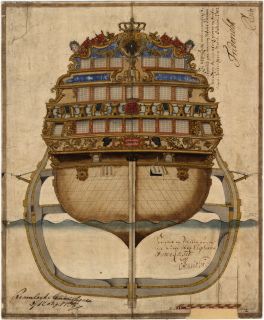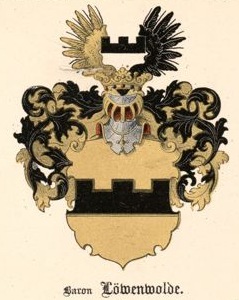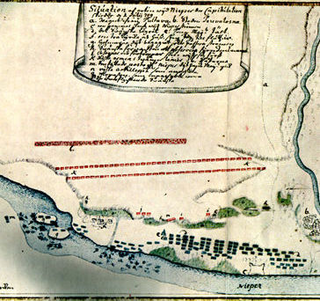 W
WThe Great Northern War (1700–1721) was a conflict in which a coalition led by the Tsardom of Russia successfully contested the supremacy of the Swedish Empire in Northern, Central and Eastern Europe. The initial leaders of the anti-Swedish alliance were Peter I of Russia, Frederick IV of Denmark–Norway and Augustus II the Strong of Saxony–Poland–Lithuania. Frederick IV and Augustus II were defeated by Sweden, under Charles XII, and forced out of the alliance in 1700 and 1706 respectively, but rejoined it in 1709 after the defeat of Charles XII at the Battle of Poltava. George I of Great Britain and the Electorate of Hanover joined the coalition in 1714 for Hanover and in 1717 for Britain, and Frederick William I of Brandenburg-Prussia joined it in 1715.
 W
WThe Campaign of Grodno was a plan developed by Johann Patkul and Otto Arnold von Paykull during the Swedish invasion of the Polish–Lithuanian Commonwealth, a part of the Great Northern War. Its purpose was to crush Charles XII's army with overwhelming force in a combined offensive of Russian and Saxon troops. The campaign, executed by Peter I of Russia and Augustus II of Saxony, began in July 1705 and lasted almost a year. In divided areas the allies would jointly strike the Swedish troops occupied in Poland, in order to neutralize the influence the Swedes had in the Polish politics. However, the Swedish forces under Charles XII successfully outmaneuvered the allies, installed a Polish king in favor of their own and finally won two decisive victories at Grodno and Fraustadt in 1706. This resulted in the Treaty of Altranstädt (1706) in which Augustus renounced his claims to the Polish throne, broke off his alliance with Russia, and established peace between Sweden and Saxony.
 W
WWith the Capitulation of Estonia and Livonia in 1710 the Swedish dominions Estonia and Livonia were integrated into the Russian Empire following their conquest during the Great Northern War. The Livonian nobility and the city of Riga capitulated on 4 July (O.S.) / 15 July 1710 (N.S.), Pernau (Pärnu) in August, and the Estonian nobility and the city of Reval (Tallinn) on 29 September (O.S.) / 10 October (N.S.). Russia left the local institutions in place and confirmed the traditional privileges of the German nobles and burghers as was established in Privilegium Sigismundi Augusti, especially with respect to the Protestant faith. The land reform of the so-called reduction which had been introduced by the Swedish king Charles XI, and transformed many serfs to subjects of the Crown, was reversed.
 W
WThe Carolean Death March or the Catastrophe of Øyfjellet is the disastrous retreat by a Swedish-Carolean army under the command of Carl Gustaf Armfeldt across the Tydal mountain range in Trøndelag around the new year 1718–1719.
 W
WThe Dannebroge was a Dano-Norwegian ship-of-the-line that exploded and sank on 4 October 1710, during the Great Northern War. Almost all of its crew of 600 were killed - one third of the victims were Norwegians. Admiral Iver Huitfeldt was among the casualties.
 W
WHDMS Elephanten was a ship of the line of the Royal Dano-Norwegian Navy that served from 1703 to 1728. There were three other Danish ships-of-the line of the same name, dating from 1684, 1741 and 1773. The ship was sometimes referred to as Nye Elefant to differentiate from others of similar name. For much of her service career, which coincided with the Great Northern War, Elephanten was the flagship of the Danish fleet active in the Baltic Sea.
 W
WGerhard Johann von Löwenwolde was a Baltic German Estonian knight. In the 1690s, he announced support of Johann Reinhold von Patkul's lobbyism against Swedish absolutist threats to Baltic noble privileges, while also working with the Swedish authorities in Estonia. He served in the Swedish army, and in 1697 was promoted major of the Swedish garrison in Riga. During the Great Northern War, he first served Augustus the Strong of Saxe-Poland–Lithuania, and after taking an ambiguous stance towards August and Peter the Great of Russia entered Peter's service after the Capitulation of Estonia and Livonia in 1710. He served as Peter the Great's plenipotentiary of Livonia during the same year, and held that office until 1713, when he became hofmeister in the service of Princess Charlotte of Brunswick-Wolfenbüttel, wife of Peter's son Alexei Petrovich, Tsarevich of Russia.
 W
WNaval Blockade of Reval (1726)
 W
WNorrtälje is a locality and the seat of Norrtälje Municipality, Stockholm County, Sweden with 17,275 inhabitants in 2010. It is one of the largest towns in Roslagen.
 W
WThe Great Northern War was the war fought between a coalition of Denmark–Norway, Russia and Saxony-Poland on one side and Sweden on the other side from 1700 to 1721. It started by a coordinated attack on Sweden by the coalition in 1700, and ended 1721 with the conclusion of the Treaty of Nystad, and the Stockholm Treaties. As a result of the war, Russia supplanted Sweden as the dominant power on the shores of the Baltic Sea, becoming a major player in European politics.
 W
WThe surrender at Perevolochna was the capitulation of almost the entire Swedish army on 30 June 1709 (O.S.) / 1 July 1709 / 11 July 1709 (N.S.). It signified the annihilation of the once formidable Swedish army after the defeat at Battle of Poltava, and paved the way for the eventual Russian victory in the Great Northern War. After the Battle of Poltava, Charles XII escaped to Moldavia, a vassal state of the Ottoman Empire.
 W
WThe Swedish invasion of Poland (1701–1706), also known as Charles XII's invasion of Poland or the Polish front of the Great Northern War, was a conflict in eastern Europe overshadowed by the ongoing Great Northern War fought between the Swedish Empire against the Russian Empire, Denmark-Norway, Saxony and the Polish–Lithuanian Commonwealth. The Polish front was a major part of the greater conflict, and it included some decisive battles in favor of the Swedes that contributed to the length of the war.
 W
WThe Russian Pillage, is the name for the action of the Imperial Russian Fleet toward the Swedish civilian population along the Swedish east coast, as well as expeditions and the raids of single unit in the inland, during the finishing years of the Great Northern War in 1719–1721. The purpose was to pillage, sack and burn to force the Swedish regime to concessions during the peace negotiations on Åland. The Swedish representative, Georg Heinrich von Görtz, was at the time stalling the negotiations in hope of military support from Great Britain. Peter the Great, on the other hand, wished for a swift end to the war, which would make it possible for him to focus on inner reform.
 W
WThe Skirmish at Bender was devised to remove Charles XII of Sweden from the Ottoman Empire after his military defeats in Russia. It took place on 1 February 1713 on Ottoman territory, in what is now the town of Bender, Moldova.
 W
WThe invasion of Russia by Charles XII of Sweden was a campaign undertaken during the Great Northern War between Sweden and the allied states of Russia, Poland, and Denmark. The invasion began with Charles's crossing of the Vistula on 1 January 1708, and effectively ended with the Swedish defeat in the Battle of Poltava on 8 July 1709, though Charles continued to pose a military threat to Russia for several years while under the protection of the Ottoman Turks.